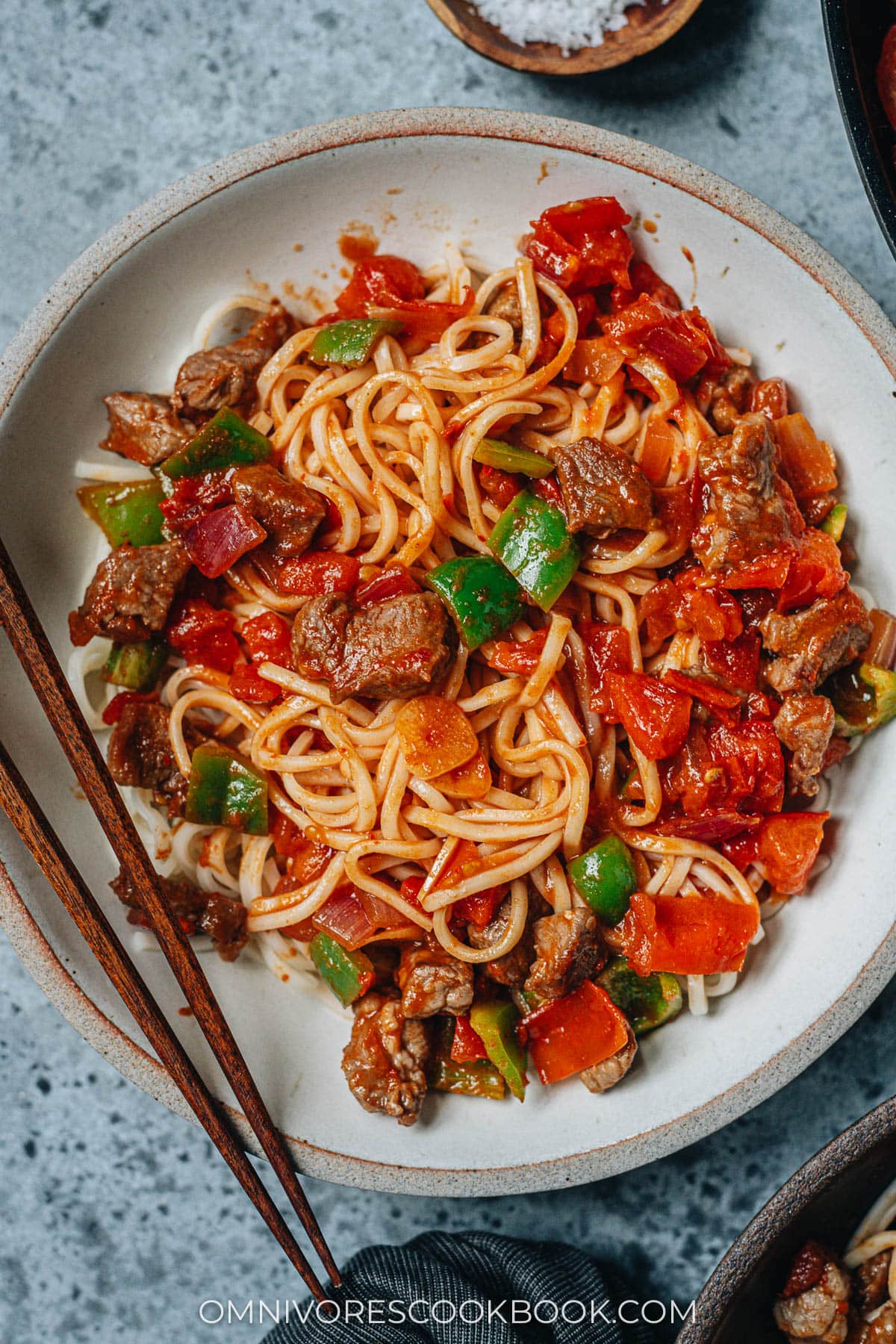
What is laghman?
Laghman (新疆拌面, Xinjiang Ban Mian) is a traditional noodle dish originating in the Xinjiang region, which is home to a significant Uyghur population.
Laghman usually uses freshly made noodles served with a sauce of stir fried meat and vegetables. The stir-fry often includes ingredients like onions, peppers, tomatoes, and garlic, and is seasoned with cumin and chili flakes. The combination of these vegetables with the meat creates a rich and flavorful sauce.
This dish reflects the cultural blend of Central Asian and Chinese influences that characterize Uyghur cuisine.
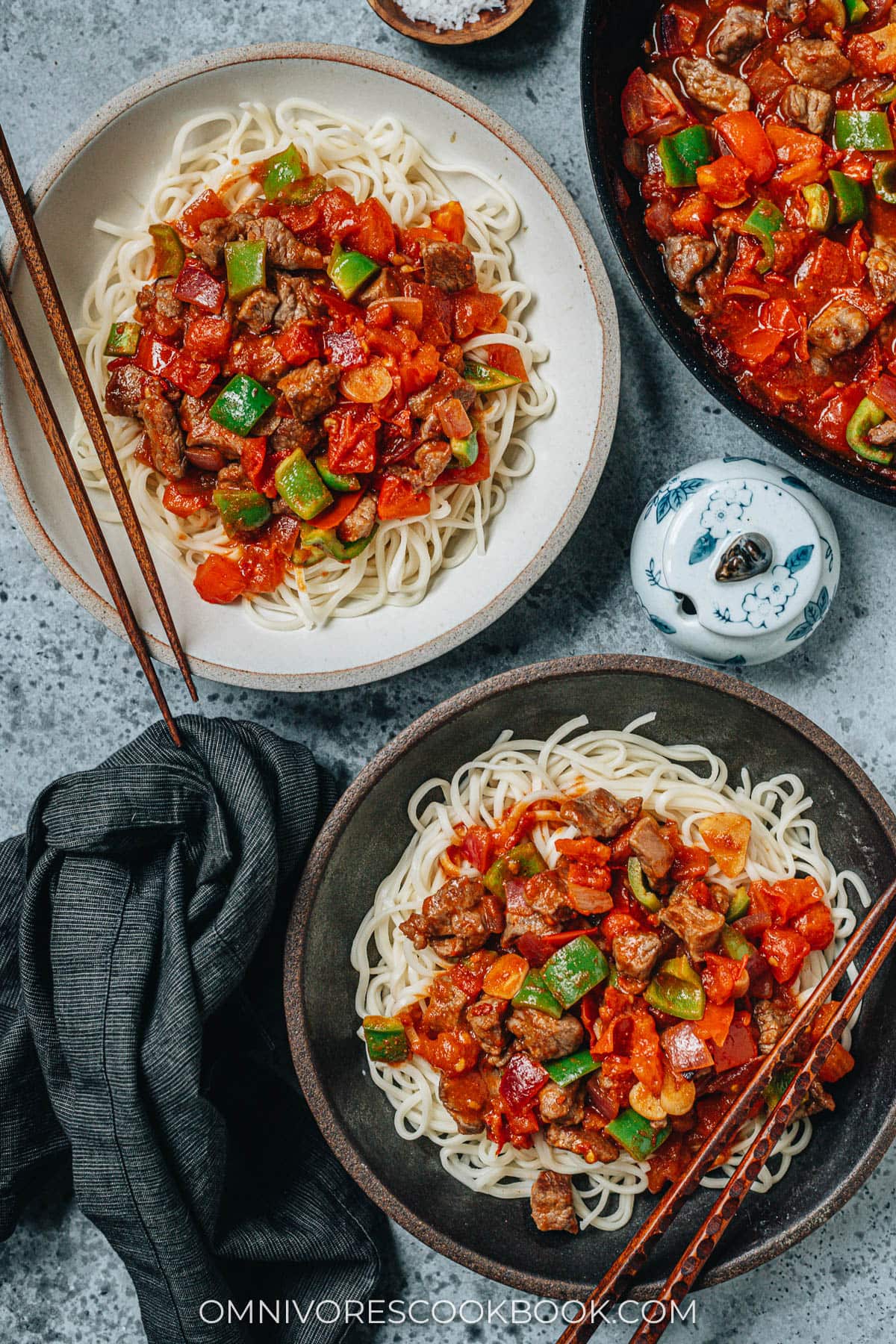
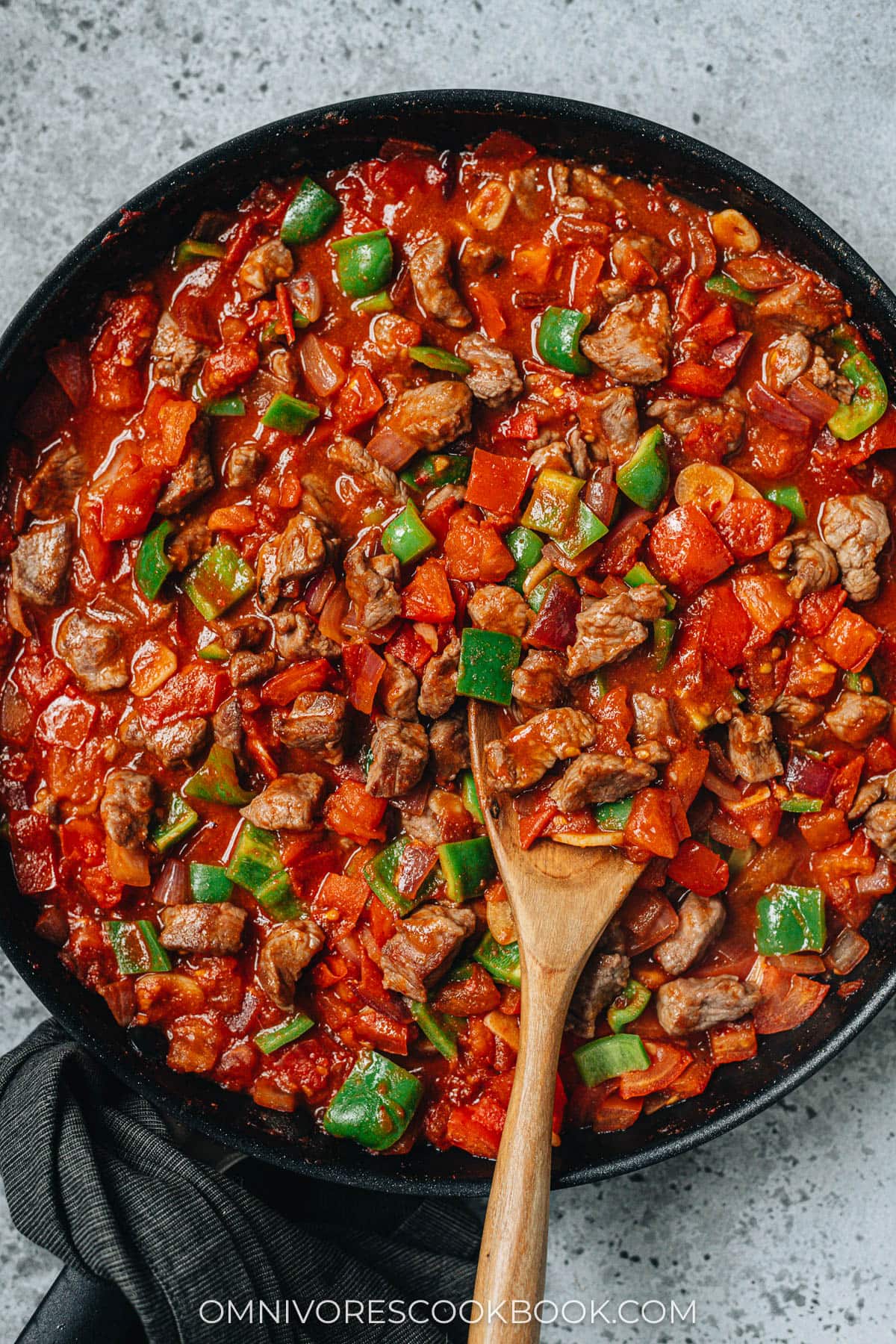
Ingredients for laghman
What type of noodles to use in laghman?
The best type of noodles to use in laghman are fresh homemade noodles. Either hand pulled noodles or rolled noodles work well.
If you do not have time to make homemade noodles, don’t worry! A lot of store-bought wheat noodles work really well in this dish, as well.
I used Havista brand “Wife’s Noodles”, which is a type of wheat noodle that has a similar shape to spaghetti. They are thick enough for a chewy texture, and thin enough to soak up the tomato sauce. You can find these noodles in the refrigerated or freezer section at large Asian grocery stores and Chinese markets.
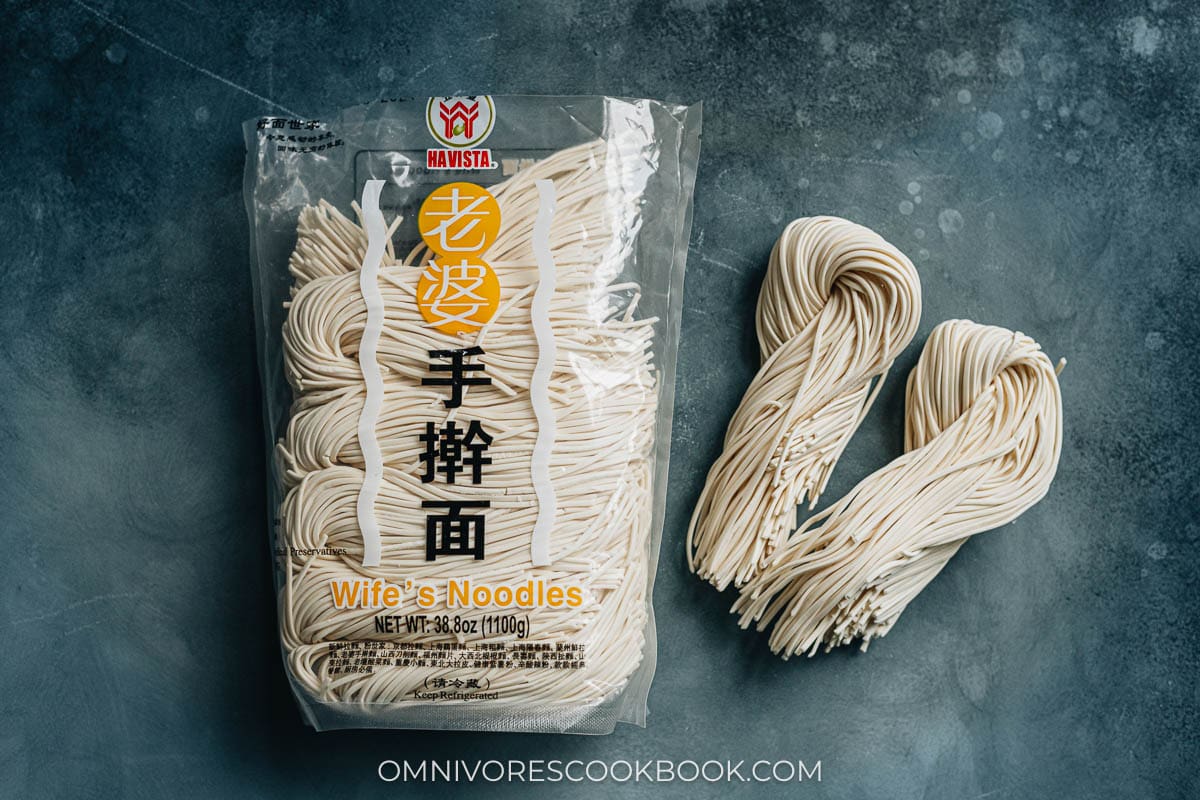
Dried noodles such as udon noodles or noodles that have a similar shape work nicely as well. The main ingredients should be wheat and water.
What cut of lamb to use?
Lamb leg is my favorite cut to use in laghman. It’s very flavorful and just fatty enough to be juicy and tender. Alternatively, you can also try it with lamb stew meat. For a cheaper option, it’s also great to use ground lamb. Ground lamb is easier to source, stays tender during cooking, and creates amazing flavor as well.
Can I use a different meat for laghman?
Xinjiang cuisine is quite famous for using lamb and it’s a staple in many dishes. But if you do not want to use lamb, beef is a great alternative in this dish. The flavors of the dish work really well with cuts of beef such as flank steak, or ground beef.
Mise en place
When you’re ready to cook, your table should have:
- Marinated lamb
- Diced tomato (or canned tomato)
- Sliced red onion
- Sliced pepper
- Noodles
- Sliced garlic
- Chinese chili flakes
- Tomato paste
- Cumin powder
- Soy sauce
- Salt and sugar
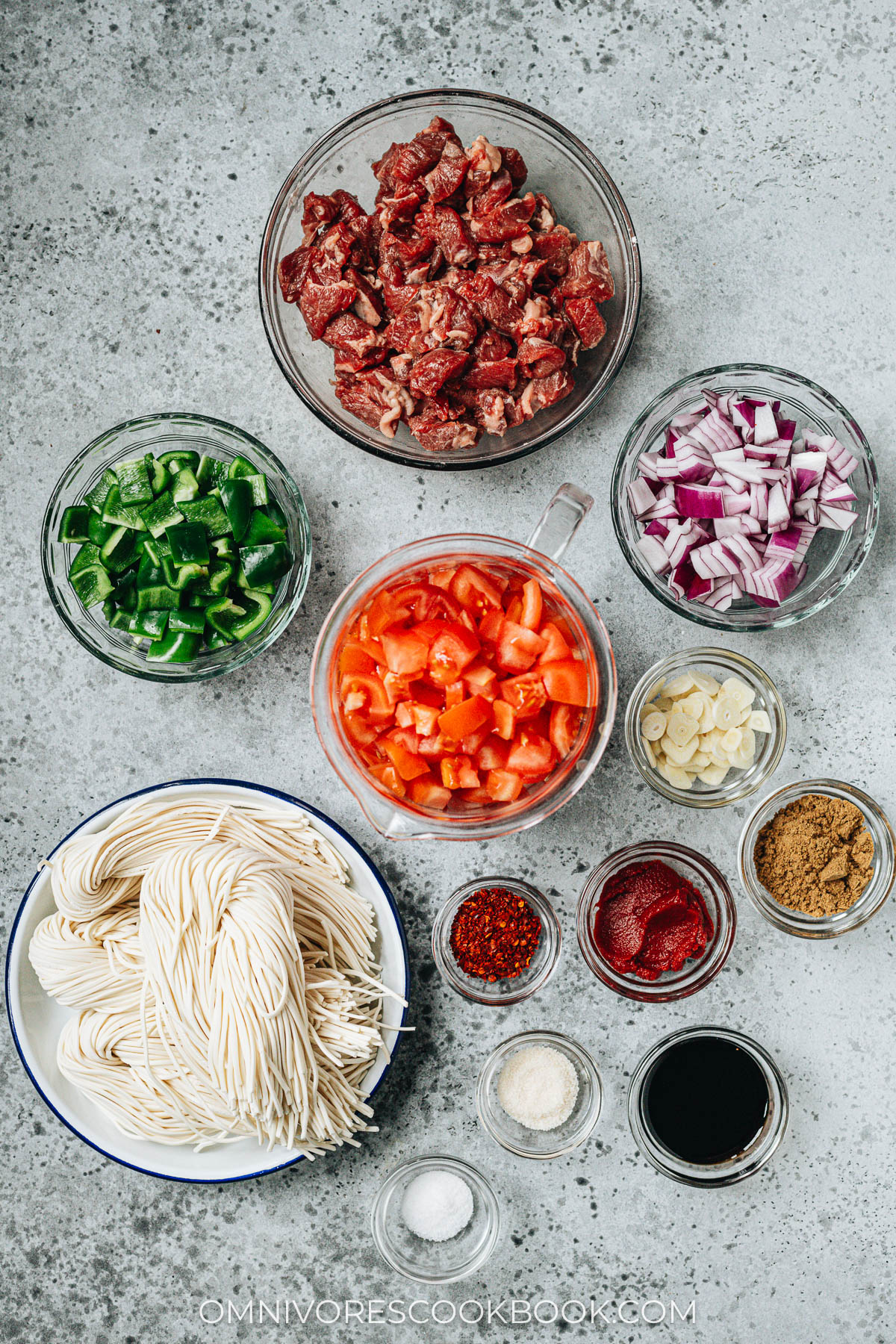
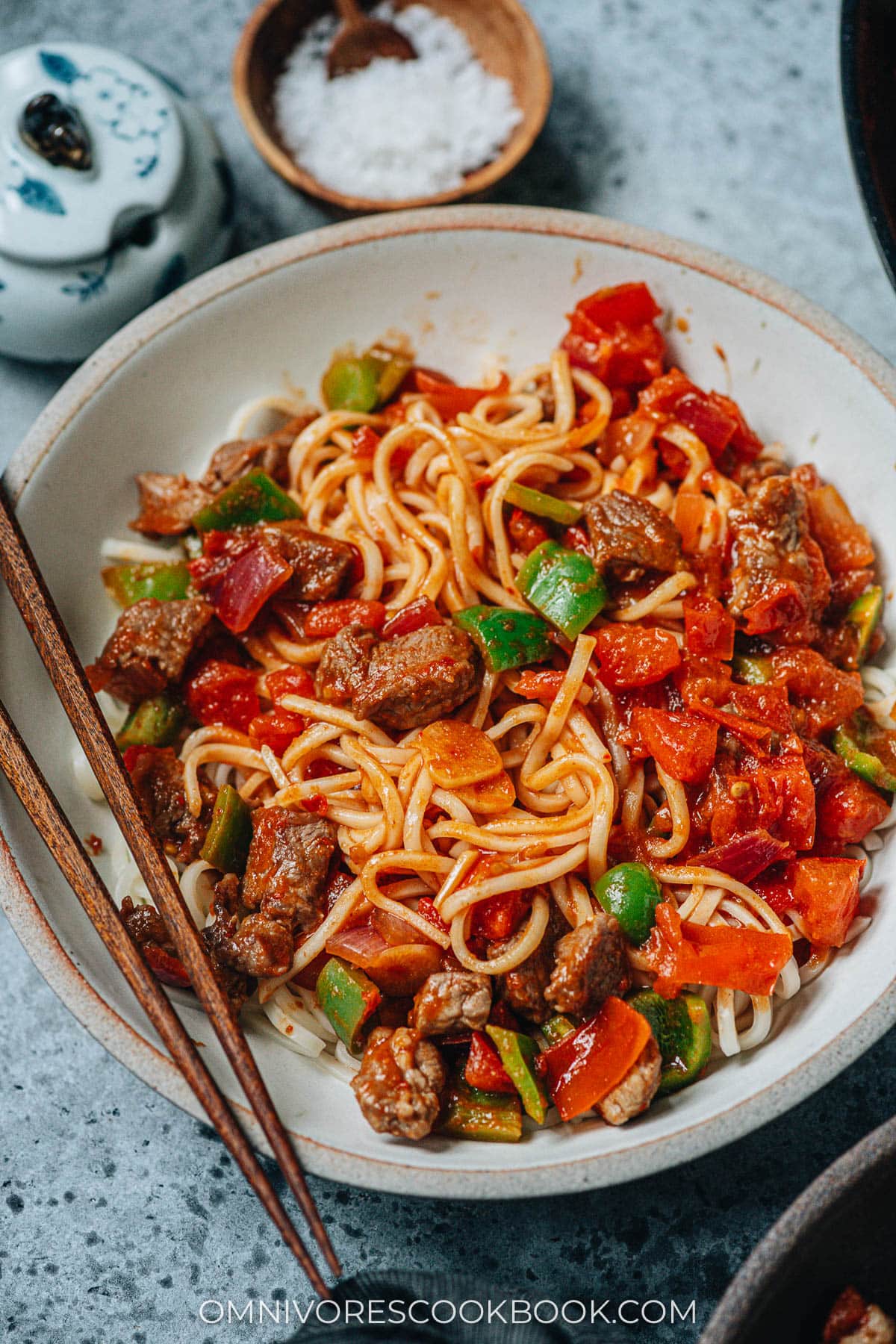
How to cook laghman
Cooking laghman is quite easy once you have all the ingredients gathered:
- Brown the lamb and transfer it to a plate
- Saute the red onion
- Toast the chili flakes and garlic
- Cook the tomato until it starts to break down
- Add the seasonings and braise
- Add the pepper
- Return the cooked lamb to the pan
- Mix everything together and adjust the seasoning if needed
While the sauce is cooking, you should also boil the noodles on the side, so everything will be done around the same time.
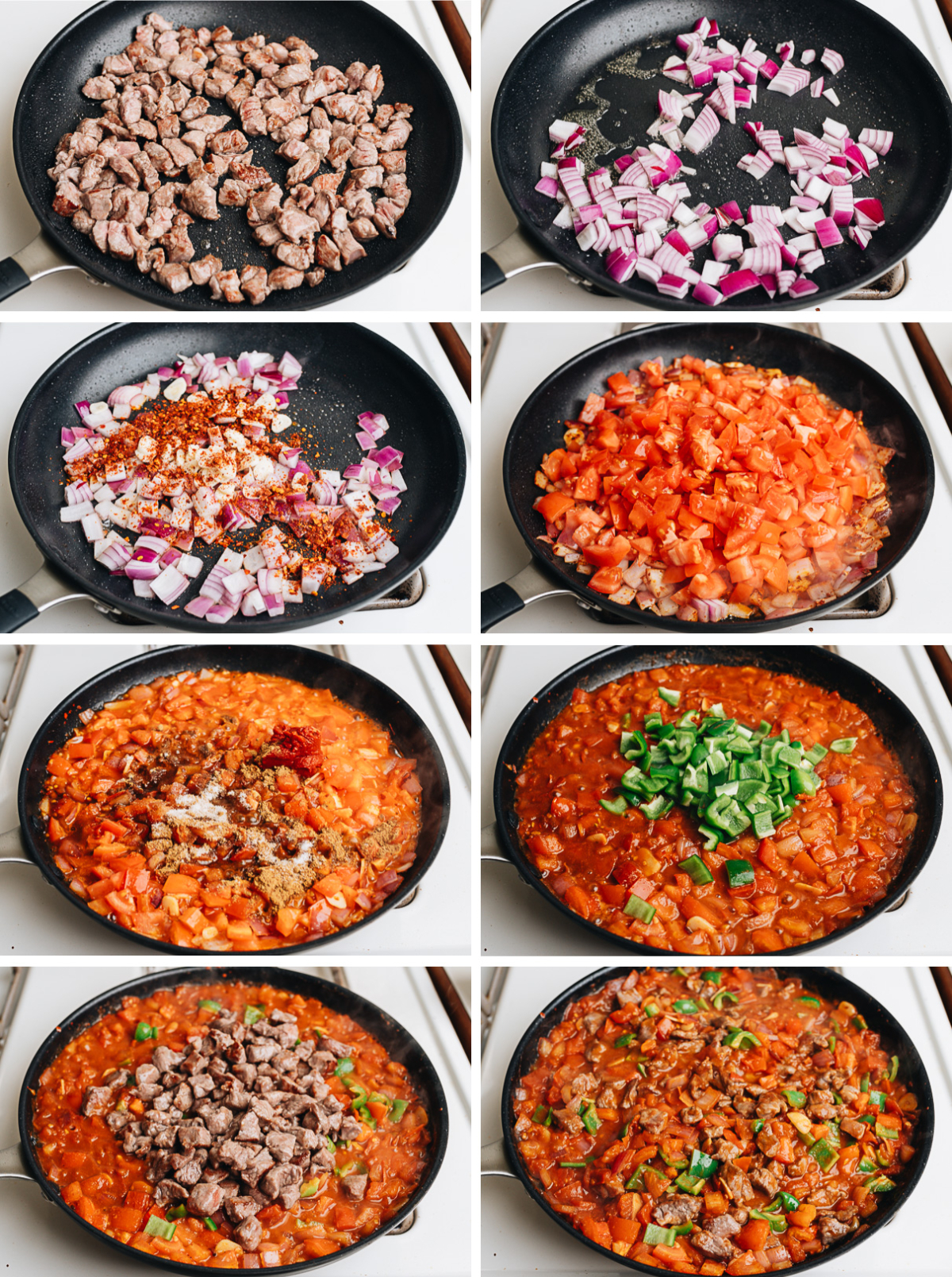
How to serve laghman
To serve laghman, simply place the noodles in individual bowls and add plenty of lamb sauce. Stir everything together and enjoy it as a main dish.
In China, laghman is a dish we usually order from small hole-in-the-wall diners for a quick lunch. Sometimes the restaurant might bring out pickles or a simple cucumber salad to go along with it. At home, this is a hearty dish you can serve for lunch or dinner. The sauce can be easily made ahead of time and served later, making it perfect for meal prep as well.
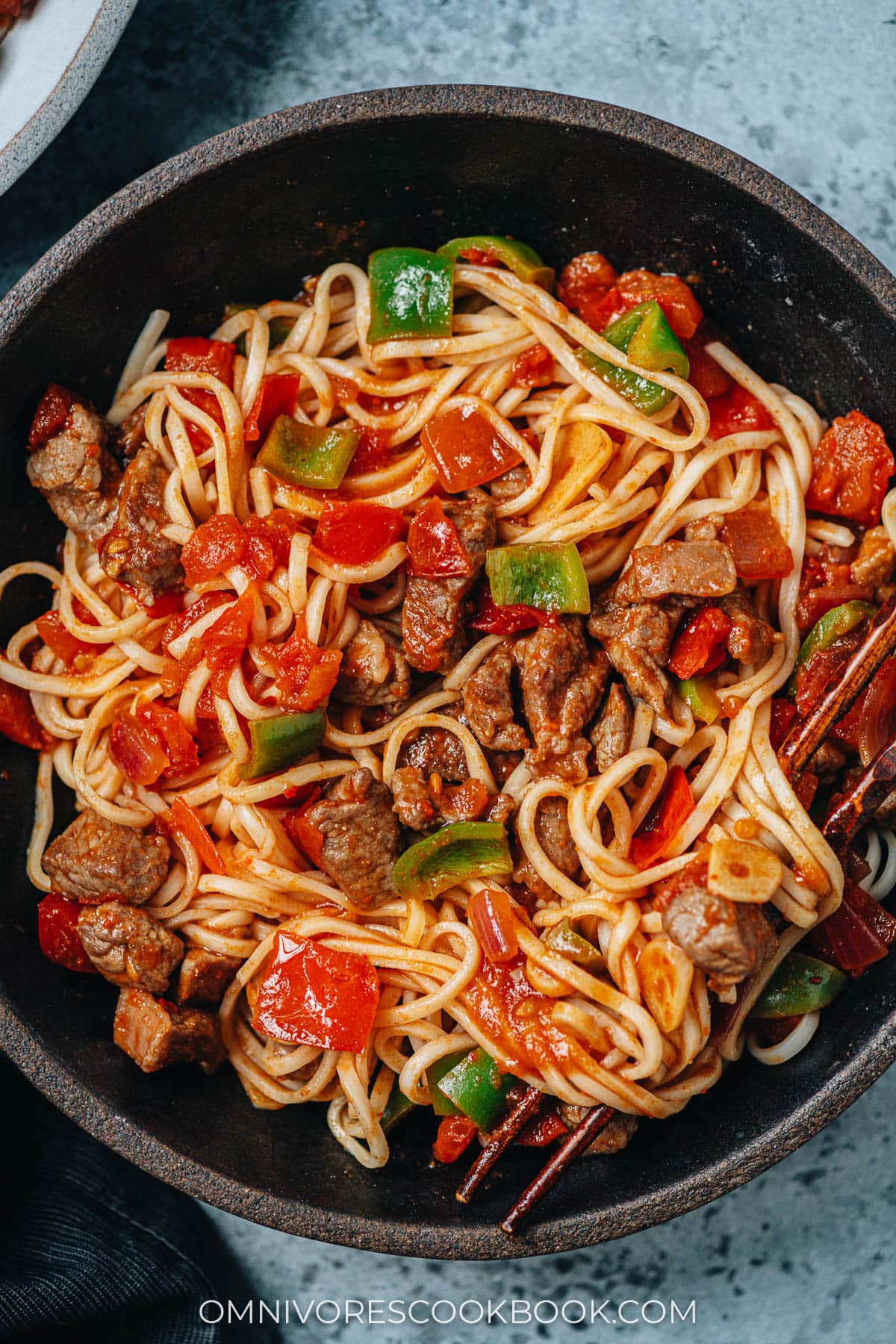
Other delicious noodle dishes
- Biang Biang Noodles (Yu Po Mian)
- Shanghai Scallion Oil Noodle (葱油拌面)
- Chongqing Noodles (重庆小面)
- Lanzhou Beef Noodle Soup (兰州拉面)
- Green Bean Noodles (豆角焖面)
Chinese Cooking Made Easy
Are you new to this website? This free email series is a great place to start. I’ll walk you through a few of my most popular recipes and show you how and why they work. You’ll quickly start to cook better Chinese food in your own kitchen.
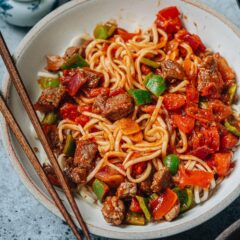
Noodles with Lamb Sauce (Laghman, 新疆拌面)
Ingredients
Marinating
- 1 lb (450 g) lamb leg or ground lamb
- 2 teaspoon peanut oil (or vegetable oil)
- 1 teaspoon salt
- 1/4 teaspoon white pepper powder
- 2 teaspoons cornstarch
Cooking
- 2 tablespoons peanut oil (or vegetable oil)
- 1 purple onion , diced
- 4 cloves garlic , sliced
- 2 teaspoons Chinese chili flakes
- 5 tomato , chopped (or 1 28-oz can diced tomatoes)
- 2 tablespoons light soy sauce (or soy sauce)
- 2 tablespoons tomato paste
- 2 tablespoons cumin powder
- 1 teaspoon sugar
- 1/2 teaspoon salt (or to taste)
- 2 anaheim pepper (or 1 bell pepper, diced)
- 1 to 1.3 lbs (450 to 600 g) fresh noodles (or 12 oz / 340 g) dried thin wheat noodles
Instructions
- Cube lamb leg into 1/2” (1-cm) cubes (or just use ground lamb) and add it to a medium-sized bowl. Add the rest of the marinating ingredients. Mix well and allow to marinate at room temperature for about 15 minutes while preparing the other ingredients.
- Add water to a large pot and bring to a boil. Cook the noodles according to instructions. Then transfer to a colander to drain. Run the noodles with cold tap water to stop cooking. Drain again and set aside.
- Heat 1 tablespoon of oil in a large skillet over medium-high heat until hot. Add the lamb and spread out with minimal overlap. Cook, stirring occasionally, until the surface turns light brown but the meat is still slightly pink inside, about 2 minutes. Transfer the lamb to a plate and set aside. Save the oil in the skillet.
- Pour in the remaining 1 tablespoon of oil. Add the onion. Stir and cook for 2 to 3 minutes, until the onion starts to soften.
- Add the garlic and chili flakes. Stir and cook to release fragrance. Add the tomato. Stir and cook for 2 to 3 minutes, until the tomato starts to break down. Add the light soy sauce, tomato paste, cumin powder, sugar, and salt. Stir and cook to mix everything well, until the tomato has broken down and becomes saucy.
- Add the pepper. Stir and cook until just softened but still crisp, 1 minute if using anaheim pepper, 2 to 3 minutes if using bell pepper.
- Return the lamb back to the skillet and stir to mix well. Cook just long enough so the lamb is warmed through and not overcooked. If you’re using ground meat, you can cook it a bit longer to release more flavor and it won’t overcook.
- To serve the noodles, fluff the noodles again and transfer to each serving plate. Add the noodle sauce. Stir to mix well and enjoy while hot!
Nutrition

Did you make this recipe?
I’d love to hear how it turned out for you! Please take a moment to leave a 5-star rating ⭐️ and share your thoughts in the comments further down the page. It really helps others discover the recipe too.

Luke
I may have made it a touch too spicy and overused a couple of spices, but this was very nice. I didn’t have specifically “Chinese chilli” and mine were pretty hot. I all used a different noodle. BUT I loved it. Thanks! The lamb was beautiful and I used red and green capsicums for peppers. Beautiful!
Maggie Zhu
So happy to hear you like the recipe! Chinese chili flakes are not very spicy and I use them to add flavor more than making the dish spicy. I’ve also tried making this dish without any chili flakes and it was also quite nice (maybe a bit lacking, but still delicious). You can definitely use less chili flakes or use some paprika to make it less spicy.
Luke
Mongolian lamb? I thought that was a staple in NSW Chinese! That’s where I am and we have that a lot. This one was very nice.
Imelda
I found your uygur noodle Recepy. It’s different from the restaurant I eat.well I will try n error then
Thank you
Darcy Sromek
I just found your blog and I am absolutely in love! My husband and I lived in XinJiang for a year and we sincerely miss XinJiang styled food. Thank you so much for sharing these creations, I can’t wait to recreate them in the States!
HL
Hi your photo shows that you’ve added celery but it’s not in your ingredients list?
Maggie
The green veggie in the pictures are peppers, not celery.
Jason
Maggie, this sounds really good! At first it seemed strange to me that there were no liquid components in the recipe, like soy sauce or vinegar or the like, but I’m assuming that this makes the vinegar and chili oil drizzle at the end a pretty crucial part of the dish, no? The combination of all of the ingredients in the main recipe sounds very delicious and intriguing to me, so I will likely be trying this soon…well, as soon as I can get my hands on some black vinegar! I just made a big batch of your chili oil to put in the fridge for when that day rolls around. Thanks for the inspiration, and the bit of history/culture in your description! I hope you have a great day! 🙂
Maggie
Hi Jason, the original recipe I learned from used a relatively dry sauce. The tomato will release some liquid after cooking though. Yes, the vinegar and chili oil is a crucial part, and I know some people will add a LOT. If you just want to try out the noodle sauce and do not have black vinegar at home, you can add a bit chicken stock at the end of cooking. And then serve it with chili oil, I bet it’ll be super delicious too.
Happy to hear you like my chili oil recipe and my blog 🙂 You too, have a great week ahead!
Kevin | keviniscooking
So loving this dish. Lamb is big in my house and your tip with the cornstarch is one I will start to implement. Thanks!
Maggie
Thanks for stopping by Kevin! Yep, the cornstarch thing is really helpful and I use it for all my stir fried meat dishes. Glad it’s helpful 🙂
Robyn @ Simply Fresh Dinners
Maggie, I could eat this dish for dinner every single day. A perfect, healthy comfort food that’s easy to prepare yet so full of flavour. I have been pondering buying some lamb for some time now and I will do it this weekend and cook this dish. It’s calling to me! I can get ground lamb at the organic farm, that would be ok, right?
I can hardly wait to taste this. Great recipe!
Maggie
Organic lamb sounds so fancy! Yep, the ground lamb will work perfect for this dish! Let me know how the dish turn out. Happy cooking! 🙂
Allie | Baking a Moment
What an incredibly flavorful dish and so satisfying! I love learning so much about authentic Chinese food from you, Maggie!
Kathleen | HapaNom
Oh my, this looks amazing! Give me a big bowl of noodles, and I’m a very happy woman. I love the all of the incredible flavors in this dish. It’s so interesting to see lamb – like Nagi said, I never really associated lamb with Chinese cuisine. Very interesting!
Helen @ Scrummy Lane
Wow, I’m not so keen on the garlic-chomping part either, Maggie, but I LOVE the sound of everything else! You are showing me how simple Chinese food can be and I LOVE that, too!
Lisa Kaufer-Smithey
YUM, I love lamb, but like Nagi I also do not associate lamb with China! They must have many lamb breeders? as you have quite a few lamb recipes. Your noodles look amazing, nothing a store bought noodle could replicate. HAPPY CHINESE NEW YEAR- enjoy time with all your loved ones!
Lisa Smithey
PS. Maggie, whenever I go to my favorite Asian market I see cleavers, as in MEAT cleavers. Are these a huge part of your daily use in cooking? They are not super expensive, I just don’t know if I need one, what do you think?
Maggie
Hi Lisa, Happy Chinese New Year to you and your family!
Lamb is not often seen in southern Chinese cooking, but in northern, middle and west parts of China, it’s a very popular meat. And it’s the main source of protein for the large Muslim population in these areas. I will post a few more lamb recipes soon (to celebrate the year of the sheep), hope you’ll like them 🙂
Yep, meat cleaver is a must have for almost every Chinese family. Even for cutting veggies, some people prefer to use it over chopping knife. Also because we really like cooking with bone-in meat, so a cleaver comes in handy when you need to chop raw or cooked bone-in chicken, or pork ribs. About whether to buy one or not, it’s really depend on how you like the food prepared. If you like authentic Asian flavor and would like to cook with bone-in meat, I suggest you to get one 🙂
Nagi@RecipeTin Eats
All these lamb Chinese dishes you share are fascinating to me. I so do not associate lamb with Chinese food – I have never seen it in Australia and I didn’t travel to the northern/western regions in China. The flavours are honestly like Middle Eastern – but with noodles! Adore adore adore!!
Marissa | Pinch and Swirl
You cook the best food Maggie! I’ve got to try this!
mira
Love these noodles, so delicious! And the sauce sounds amazing! Great post and step by step photos Maggie! pinned!
Kelly – Life Made Sweeter
These noodles look gorgeous! I love that you made them by hand, so impressive! I could eat noodles all the time, this looks mouthwatering!
Bam’s Kitchen
Gorgeous homemade noodle dish and love that sauce. There is something about homemade noodles that makes me want seconds…
Alice @ Hip Foodie Mom
Maggie, I still can’t believe you made these gorgeous noodles by hand!!! WOW!! I love this! I could eat Asian noodle dishes all week!